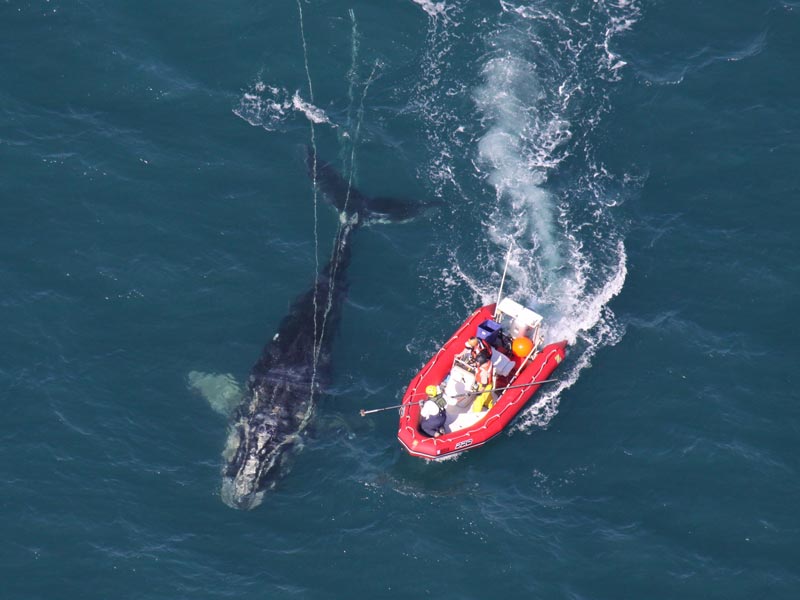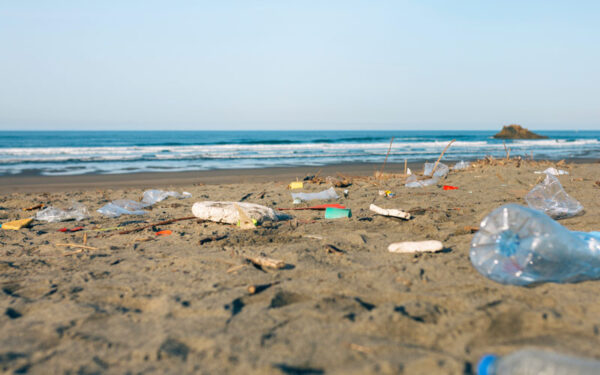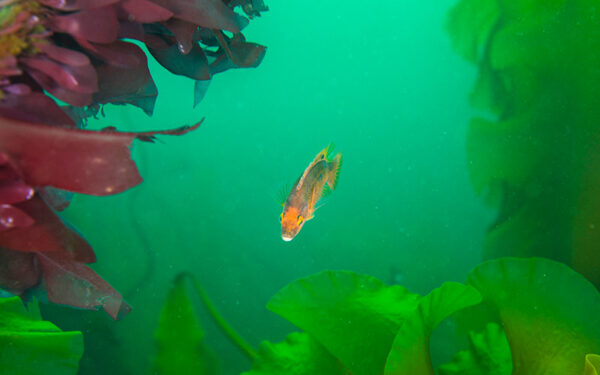
Generation after generation, North Atlantic right whales can't escape the deadly threats of entanglement. These incidents put the lives of right whales and rescue teams who attemp to free them in constant danger. Photo: NOAA News Archive 011811
In February 2020, researchers spotted a rare North Atlantic right whale struggling in the frigid waters off the coast of Massachusetts. She looked weak and pale, her mouth propped open unnaturally and her head infested with lice. Soon identified as 19-year-old Dragon, she was fighting to feed while wrapped in thick fishing rope, with a bullet buoy stuck in her jaw.
Sadly, the team sent to free her couldn’t – her condition was too fragile, and it would have been dangerous, if not impossible, for them to try. Unintentional entanglements like this one pose a daily threat to right whales, cutting their lives short and painting a disheartening future for this species.
A Lost Mother
As a mother of three calves, Dragon had been a pillar of hope and resilience for the future of this critically endangered species – one with fewer than 350 animals remaining, only 90 of which are breeding females. But her condition and disappearance, more than two years ago, indicate that Dragon likely suffered an agonizing death from starvation. For a species that is struggling to rebuild its population, the loss of a mother is a tragedy.
Generations of Whales Enduring Trauma
Dragon is not the first member of her family to suffer as a direct consequence of human activities. In 2003, a vessel struck and killed a whale identified only as #2150. The necropsy revealed that beyond blunt force trauma, hemorrhage, and hypothermia, the whale had also suffered entanglement injuries to her head. #2150 was only 12 years old; #2150 was Dragon’s mom; Dragon was barely 2 years old when she was orphaned.
Right whales can and should live for up to 75 years. Were she alive today, Dragon’s mom would be roaming the ocean for decades to come. She also would have given birth to several more calves. Instead, her skeleton lies in a Canadian museum bearing witness to the dangers that these animals face.
Just a few months later, another entangled whale was spotted off the coast of New Jersey. In a sad twist of fate, the 4-year-old calf, also known as #4680, was Dragon’s son. According to reports by NOAA, at least two long fishing lines were wound and embedded across the calf’s head. And, from the photos, experts noted that the calf also had a large open wound on its shoulder. As soon as weather conditions allowed it, a search-and-rescue team was launched, but they were unable to locate the young whale again. Since then, the search has stopped.
Not the New Normal
Dragon’s family is not unique. Nearly every right whale family tree has a trail of accidental entanglements in gear associated with trap/pot or gillnet fisheries in the U.S. and Canada.
In October 2020, just after Dragon’s calf was reported entangled, an 11-year-old male, Cottontail, was spotted with a fishing line hanging from both sides of his mouth. The trailing rope, which was hundreds of feet long, exceeded at least four times the length of the whale’s body. A response team arrived to attempt a rescue. But, due to harsh sea conditions, they were only able to remove 100 feet of the rope.
The team placed a tracker on the whale so they could find him again when sea conditions improved. However, Cottontail lost the tracker after swimming 700 miles over the course of several days, all while dragging the remaining gear. Sadly, on March 2021, scientists reported finding the carcass of Cottontail. His dead body, which was found surrounded by great white sharks, was still wrapped by fishing gear rope.
Statistics show that as many as 85% of all North Atlantic right whales bear scars from entanglement. This is particularly concerning because entanglement injuries directly impact whales’ ability to give birth and reproduce at a healthy rate. In fact, healthy females can give birth to one calf every 3 to 4 years. But today, that number is closer to every 6 to 10 years – which makes it even more difficult for this species to rebuild its population.
Our Voices Can Make a Difference
This fight is far from over. Immediate actions to prevent entanglements and ship strikes (another big threat to whales’ survival) can recover this species. CLF and our partners are demanding that federal agencies take immediate action and that Congress funds solutions to turn this situation around.
Options include:
- closing areas where these animals congregate to feed and socialize until fishing without vertical lines becomes widely available;
- requiring mandatory speed restrictions along the Atlantic seaboard for vessels that are large enough to kill a whale;
- increasing funding for research and collaborative efforts to eliminate vertical fishing gear lines in the water;
- mitigating the impacts of offshore wind development on the species; and
- demanding better monitoring of the whales and the fisheries that affect them.
Right whales can only recover if we act together now.
At CLF, we have been advocating for this species through legal action as well as legislative and educational initiatives. And we have made strides in that direction.
Just recently, a federal judge ruled in favor of CLF and our partners in a long-running case challenging NOAA Fisheries’ failure to protect critically endangered North Atlantic right whales from entanglements in American lobster fishing gear. The ruling made it clear that fishery managers must do more to protect this species.
It’s up to us to help this species make a comeback and put an end to this torturous tug of war.
You can help. Stay tuned to learn more about this species, the key role that they play in our marine ecosystem, and upcoming opportunities to speak up on behalf of these beautiful animals.
*An earlier version of this blog was published on December 8, 2020.




